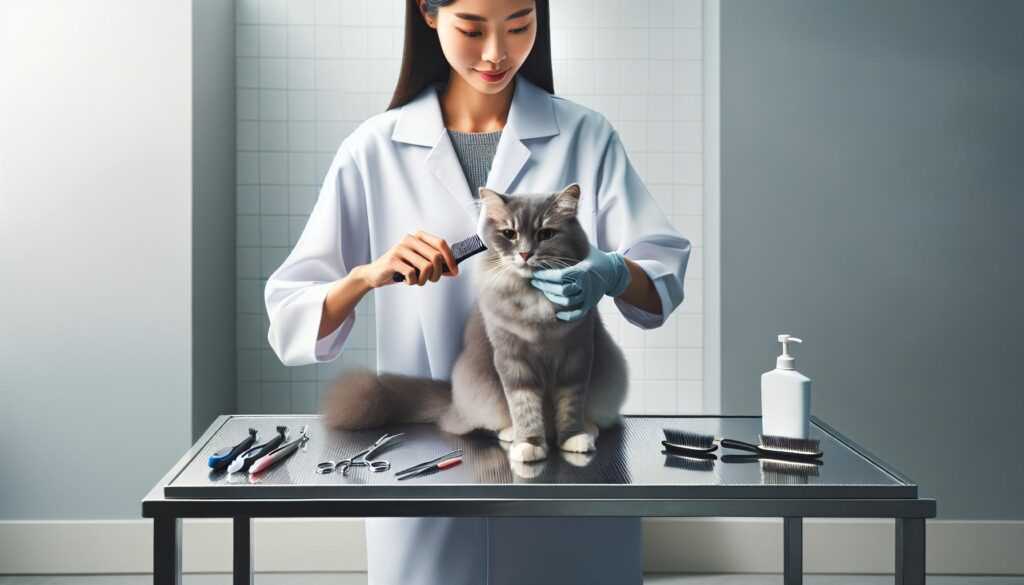Discovering that your beloved feline friend might be showing signs of cancer can be deeply unsettling. You’re not alone in wanting to spot these symptoms early to give your cat the best chance at a healthy life.
Understanding cat cancer symptoms is crucial, and you’ve taken the first step in educating yourself. From unusual lumps to sudden weight loss, knowing what to look for can make all the difference.
Stay tuned as we delve into the common signs of cancer in cats, so you’re equipped to take swift action should the need arise. Your vigilance could be a lifesaver.
Understanding Cat Cancer Symptoms
When your beloved feline friend’s health is at stake, understanding the signs of cancer in cats can be critical. Early detection is pivotal in providing the best possible outcome for your cat’s treatment and quality of life. Here’s what you need to keep an eye out for:
- Lumps or swellings: These can be felt under the skin and should be checked by a vet, especially if they’re growing or changing shape.
- Sores that don’t heal: If your cat has persistent sores, this could indicate cancer or another serious condition.
- Weight loss: Unexplained weight loss is concerning and merits a veterinary visit.
- Loss of appetite: A sudden disinterest in food can be a sign of various illnesses, including cancer.
- Bleeding or discharge: Any unexplained bleeding, or discharge from any body opening, needs to be evaluated.
- Offensive odour: An unpleasant smell can be a sign of tumors in the mouth, nose, or anus.
- Difficulty eating or swallowing: This could suggest oral tumors or esophageal issues.
- Hesitation to exercise or lethargy: Decreased activity might be more than just age-related.
- Persistent lameness or stiffness: Ongoing limping or difficulty moving can indicate bone cancer.
While it’s important not to jump to conclusions, staying informed and vigilant is key. Regular veterinary check-ups provide the opportunity for early detection and timely intervention. Remember, not all changes will indicate cancer, but they do necessitate attention to ensure your cat’s health is not compromised.
Common Types of Cat Cancer
After recognizing the symptoms of cancer in your cat, it’s essential to understand the types they may face. Two prevalent forms of cat cancer are lymphoma and mammary cancer.
Lymphoma
Lymphoma is one of the most common types of cancer affecting cats. It targets lymphocytes, a type of white blood cell essential for the immune system. Lymphoma can be found in various parts of your cat’s body, including the lymph nodes, gastrointestinal tract, and even the kidneys.
Signs of Lymphoma can mirror other illnesses, which makes close observation crucial. Symptoms might include:
- Enlarged lymph nodes
- Vomiting and diarrhoea
- Increased thirst and urination
It’s important to note that Feline Leukemia Virus (FeLV) and Feline Immunodeficiency Virus (FIV) are risk factors for developing Lymphoma. If your cat is positive for either virus, regular check-ups become even more imperative.
Mammary Cancer
Mammary Cancer, similar to breast cancer in humans, is a significant health concern in cats. It is particularly prevalent in females that are not spayed or were spayed later in life. Tumors develop in the mammary glands and can be quickly recognized by physical lumps which require immediate veterinary attention.
Key facts regarding Mammary Cancer include:
- It’s more common in females over six years
- Early spaying significantly reduces the risk of development
Regular palpation of your cat’s mammary glands during grooming sessions is a proactive way to detect abnormalities early. Weight loss and changes to the skin overlying the mammary glands can also be tell-tale signs.
Detecting the type of cancer is critical for deciding the course of treatment. Blood tests, biopsies, ultrasounds, and X-rays are common diagnostic tools used by veterinarians to determine the presence and extent of cancer. Continual communication with your vet and keen monitoring of your cat’s health can lead to prompt intervention, which may improve prognosis. Further tests, such as blood samples and x-rays, may be needed to accurately diagnose mammary tumors in cats. Unfortunately, cancer in cats can’t be identified by just looking alone, so your vet will need to do further tests, including a biopsy, to diagnose mammary cancer. Blood samples will almost always be taken in order to detect the effects of the cancer and to also make sure that another disease isn’t the cause of your cat’s cancer symptoms.
Recognizing Signs of Cancer in Cats
When your feline friend is not quite themselves, it’s important to be vigilant. Recognizing the early signs of cancer in cats can be crucial for early intervention and effective treatment. Let’s delve into some of these symptoms and understand their significance.
Unexplained Weight Loss
One of the more alarming signs that may indicate something is amiss is unexplained weight loss. If your cat starts to lose weight despite having a normal diet, it might be a red flag. Cancer can lead to weight loss in several ways:
- By causing a decrease in appetite.
- Through the cancerous cells consuming a large amount of energy.
It’s essential to monitor your cat’s weight regularly since this can be an indicator of various health issues, not just cancer.
Abnormal Lumps or Bumps
Regular petting sessions can be more than just bonding moments; they’re opportunities to feel for any abnormal lumps or bumps. These may not always signify cancer, but they warrant a veterinary check-up to rule out serious conditions. Here’s what to keep in mind:
- Any new lump or a lump that’s growing should be checked by a vet.
- Not all lumps are cancerous, but only a professional can make that determination.
Feeling for lumps should become a part of your routine when caring for your cat.
Changes in Appetite and Thirst
Cats are creatures of habit, especially when it comes to feeding. Noticing changes in appetite and thirst can be telling signs of cancer in cats. A decrease in appetite might suggest gastrointestinal tumours or systemic illness, while an increased appetite could be a sign of other health issues. Similarly, changes in thirst and urine output can be indicative of underlying conditions, including potential tumors affecting internal organs such as the intestines.
Symptom | Possible Implication
Increased thirst | Kidney disease or diabetes
Decreased thirst | Nausea or other systemic issues
Remaining aware of your cat’s eating and drinking habits can provide valuable insights into their overall well-being.
Diarrhoea and vomiting
Cancer in cats can affect their digestive system, this can be one of the signs of cancer in cats. Awareness of our cat’s discharge is Important in caring for our feline friends. This symptom comes with a lot of discomfort for cats and its accompanied by weight loss.
Diagnostic Tests for Cat Cancer
Understanding the signs of cancer in cats is essential, but it’s also vital to know about the diagnostic tests that can confirm the presence of this disease in your pet. Veterinarians use various methods to diagnose cancer, and we’ll delve into some of the most common ones below.
Biopsy
When you notice signs of cancer in cats a biopsy is often the next step. A biopsy is the removal of a small amount of tissue for examination under a microscope. It’s a definitive method to determine the presence of cancerous cells.
There are different types of biopsies:
- Fine needle aspiration involves using a thin needle to extract cells from a lump.
- Core needle biopsy is similar but uses a larger needle to collect a tissue sample.
- Punch biopsies, where a circular tool is used to get a skin sample.
- Excisional biopsies, wherein the entire lump or area is removed.
The type of biopsy your vet chooses will depend on the location and nature of the suspected cancer. For internal masses, your cat might require a surgical biopsy, which is more invasive and requires anesthesia.
Blood Tests
While blood tests alone can’t diagnose cancer definitively, they provide crucial information. A Complete Blood Count (CBC) and biochemistry profile are typically conducted. These tests assess the health of your cat’s organs and can detect abnormalities caused by cancer.
Key elements of a CBC include:
- Red blood cell count: Low levels might suggest anemia, often associated with certain cancers.
- White blood cell count: High levels can indicate an attempt to fight off cancer or other diseases.
- Platelet count: Cancer can lead to low platelet counts.
The biochemistry profile can reveal kidney, liver, or pancreatic issues that might be signs of cancer affecting these organs. Elevated calcium levels, termed hypercalcemia, can sometimes be associated with various forms of cancer in cats.
Both biopsies and blood tests are invaluable tools in a veterinarian’s arsenal to help detect and characterize cancer in cats. These procedures, combined with your vigilance at home, are your best bet in tackling this disease effectively.
Treatment Options for Cat Cancer
Once your vet has diagnosed your cat with cancer, the next step is to discuss the best course of action. Treatment options often depend on the type and stage of cancer, as well as your cat’s overall health.
Surgery
This is one of the primary treatments for many types of cancer in cats, particularly if the cancer is localized and hasn’t spread. This involves removing the tumor and sometimes, the surrounding tissue. For some cancers, surgery might provide a complete cure, but it’s often combined with other treatments.
Chemotherapy
This use of drugs to kill or slow the growth of cancer cells. It can be used alone or in conjunction with surgery. While it can be effective, it might also have possible side effects, including nausea and a temporary decrease in immune function. Fortunately, cats often tolerate chemotherapy better than humans. Another treatment option for cat cancer is photodynamic therapy, which combines light and light-sensitive substances to destroy cancerous tissue. This relatively new treatment is showing promising results in cats and may be a good alternative for those who cannot tolerate chemotherapy. However, it is only available at a few specialist centres and regular visits may be needed for a period of time.
Radiation therapy
This is another common treatment which involves targeting cancer cells with high-energy rays to destroy them. This technique is particularly useful for tumors that cannot be completely removed by surgery.
Besides these, other options may include:
- Immunotherapy: Enhancing the immune system’s ability to fight cancer
- Targeted therapy: Drugs that specifically target cancer cells without attacking normal cells
- Supportive care: Addressing pain management, nutritional support, and other aspects of care to improve quality of life
Your vet may recommend a combination of treatments, known as a multimodal approach, to enhance the effectiveness of cancer therapy. It’s essential to understand the potential benefits and risks associated with each treatment option, including cat’s quality of life during and after treatment. Make sure to ask about the likelihood of remission, the potential side effects, and how the treatments may affect your cat’s day-to-day life. Some common cancer treatments for cats include surgery, chemotherapy, radiation therapy, and immunotherapy. It is important to discuss all available options with your vet to determine the best course of action for your cat’s cancer treatment.
Providing Support for a Cat with Cancer
When your cat is diagnosed with cancer, you’ll need to provide extra care and comfort. It’s vital to maintain a stress-free environment as stress can exacerbate health issues. This means keeping their living area quiet, comfortable, and easily accessible.
Nutrition plays a critical role in your cat’s recovery. Work with your vet to develop a diet plan that supports their immune system and maintains their strength. A high-quality diet with the right balance of nutrients is essential, and in some cases, dietary supplements may be recommended.
Since mobility might be affected by the cancer or its treatments, make modifications to your home environment to accommodate your cat’s needs. This could include:
- Adding ramps or steps for easier access to favourite spots
- Placing food and water bowls within easy reach
- Ensuring litter boxes have low sides for easy entry and exit
Regular check-ups with the vet are crucial to monitor your cat’s health status and adjust treatments as necessary. Additionally, don’t underestimate the power of your presence. Spend quality time with your furry friend, offering gentle affection and engaging in light play if they’re up for it. This can greatly enhance their quality of life during this challenging time.
Conclusion
Spotting the early signs of cancer in cats is crucial for their well-being. Armed with the knowledge of symptoms and the necessary steps to take, you’re now better prepared to support your feline friend through a cancer diagnosis. Remember, a stress-free home, a tailored diet, and regular vet check-ups are key to managing your cat’s health. Above all, cherish the time you spend together, as your love and care can make a significant difference in their comfort and happiness. Stay vigilant and proactive in monitoring your cat’s health, and you’ll be doing everything you can to ensure they lead a full, contented life.
Frequently Asked Questions
What are the signs of cancer in cats?
Some common signs include unexplained weight loss, persistent sores, swelling, changes in bowel or bladder habits, and difficulty eating or breathing. Early detection is vital, so if you notice these symptoms, visit a vet promptly.
What types of diagnostic tests are used to detect cancer in cats?
Veterinarians typically use a combination of blood tests, X-rays, ultrasound, biopsies, and possibly CT scans or MRIs to diagnose cancer in cats. The type of tests will depend on the symptoms and the suspected type of cancer.
How can I support my cat who has cancer?
Supporting a cat with cancer involves creating a calm environment, consulting with your vet to develop a tailored diet plan, adjusting your home to suit their needs, ensuring regular vet check-ups, and dedicating time for affection and comfort to improve their wellbeing.
Are dietary changes important for a cat with cancer?
Yes, dietary changes can be crucial. Your vet may recommend a special diet to support your cat’s immune system and overall health. It’s essential to follow professional advice to provide the nutrients your cat needs.
What should I do to make my home more comfortable for a cat with cancer?
Consider accessible bedding, litter boxes with low sides, and keeping essentials within easy reach. Limiting stairs or creating gentle ramps can help, along with providing warm, quiet resting spots away from busy household area






